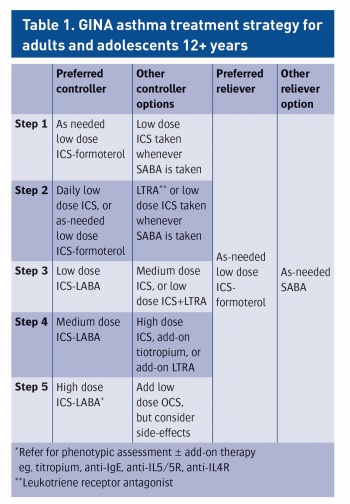RESPIRATORY
Major change to global asthma management recommendations
The 2019 GINA strategy report represents the most significant change in asthma management in 30 years
June 28, 2019
-
New global recommendations on the management and treatment of asthma purport that all adults and adolescents with asthma should receive either symptom-driven (in mild asthma) or daily low dose inhaled corticosteroid (ICS) in combination with formoterol, a long-acting beta2-agonist (LABA), as the optimal reliever therapy for the reduction of serious exacerbations across all severities.
For safety reasons, the Global Initiative for Asthma (GINA), which recently published the recommendations in its 2019 strategy, Pocket Guide for Asthma Management and Prevention,1 no longer supports the sole use of short-acting beta2-agonists (SABA), owing to the fact they do not address the underlying inflammation and the potential for their frequent or overuse to increase the risk of exacerbations.
The new recommendations are the culmination of a 12-year campaign by GINA to obtain evidence for new strategies for the treatment of so-called mild asthma. The aims were to reduce the risk of asthma-related exacerbations and death; to provide a consistent message about the aims of treatment, including prevention of exacerbations, across the spectrum of asthma severity; and to avoid a pattern of patient reliance on SABA early in the course of the disease.
Risks associated with SABA-only treatment
SABA-only treatment offers quick symptom relief but many guidelines that recommend the sole use of as-needed SABA relievers are out of date, according to the guide, and don’t allow for more recent research that associates this treatment strategy with increased risk of exacerbations and reduced lung function. Regular use of SABA increases airway inflammation, overuse (three or more canisters dispensed a year) can lead to an increased risk of severe exacerbations, and dispensing 12 or more canisters in a year has been found to increase the risk of asthma-related death, according to the GINA guide.
A stepwise approach
For the best outcomes, GINA recommends initiation of ICS-containing treatment as soon as possible after a diagnosis of asthma is made. It recommends that clinicians adopt a stepwise approach to adjusting the ongoing treatment of individual patients (see Table 1). Each step represents a patient cohort (eg. step 1 is for patients with sporadic symptoms), the preferred controller for that cohort, other controller options, the preferred reliever for that cohort and other reliever options.
 (click to enlarge)
(click to enlarge)
